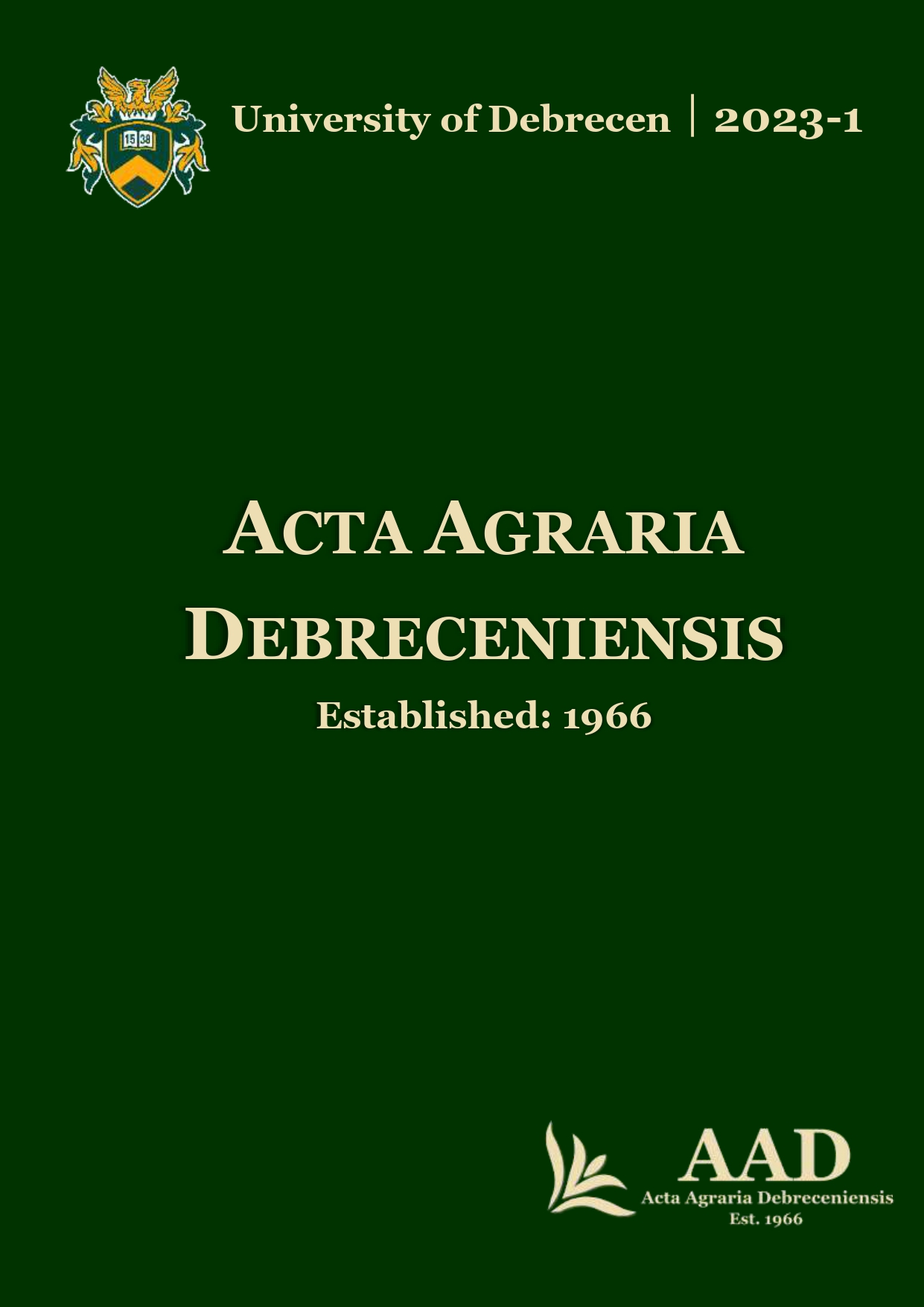Organic soybean production in Hungary
Authors
View
Keywords
License
Copyright (c) 2023 by the Author(s)

This work is licensed under a Creative Commons Attribution 4.0 International License.
How To Cite
Accepted 2023-04-19
Published 2023-06-05
Abstract
Organic soy production, particularly for feedstuff in organic animal husbandry, is needed in Hungary and the EU regions. Soybean producing crop area in Hungary has increased in the last years, however, the agroecological potential would allow for a larger soybean production area. This study presents the soybean market in Hungary, and the role of soybeans in protein supply in food and feed, summarising the critical elements of organic soybean production from variety selection to marketing. During the field research, the effects of the agronomical environment on yield potential factors were examined. We aimed to determine how different row spacing and tillage systems affect organic soybean yields of different varieties, with particular attention to the dry region, and determine the specific methods and varieties of soybean that favour these areas. We found that the tillage (plough/grubber), the spacing (wide/narrow), and the variety effects were all significant on morphological variables. The most remarkable difference was seen in plant height and the number of pods per plant, while the number of nodes was also highly impacted by tillage treatment and variety. The nutrition variables were significantly different, mainly as an effect of tillage and spacing interaction with significantly different plant responses of varieties.
References
- AgenceBio (2019): Organic Farming And Market In The European Union. https://www.agencebio.org/wp-content/uploads/2020/04/Organic_farming_market_EU_2019.pdf (Accessed 10/02/2022)
- Agrárunió (2019): A szójatermesztés helyzete Magyarországon, https://www.agrarunio.hu/hirek/novenytermesztes/5261-a-szoja-helyzete-magyarorszagon (Accessed 04/14/2023)
- Andreoli, V.–Bagliani, M.–Corsi, A.–Frontuto, V. (2021): Drivers of Protein Consumption: A Cross-Country Analysis. Sustainability 13. 2021, 7399. DOI: https://doi.org/10.3390/su13137399
- Armonk (2020): IBM Corp. Released 2020. IBM SPSS Statistics for Windows, Version 27.0. Armonk, NY: IBM Corp
- Balikó, S. (2018): A szójatermesztés kritikus elemei. https://agroforum.hu/szakcikkek/novenytermesztes-szakcikkek/szojatermesztes-kritikus-technologiai-elemei/ (Accessed 04/14/2023)
- Balikó, S.–Bódis, L.–Kralovánszky, P. (2007): A szója feldolgozása, felhasználása. Mezőgazda Kiadó, Budapest p. 180, ISBN: 9789632863412
- Berki, Gy. (2020): Bioszója termesztés Bicsérden. https://www.biokontroll.hu/bioszoja-termesztes-bicserden/?gclid=Cj0KCQjwlK-WBhDjARIsAO2sErR8KvCdhY1aCWzuYfxeO_p-DbQYDakK87pTVcQLoXU-LiAfM18tRRwaAhOPEALw_wcB (Accessed 20/1/2022).
- Bozóki, B.–Kovács, G.P.–Birkás, M.–Kende, Z.–Gyuricza, Cs. (2022): The Effects of Tillage Practices on Water Management of Soybean (Glycine max L.) DOI: https://doi.org/10.18380/SZIE.COLUM.2022.9.2.145
- Böhler, D.–Dierauer, H.–Krauss, M.–Schmid, N.–Clerc, M.–FiBL, Locher, M.–GZPK Frick. (2018): Entwicklung von Alternativen zum Pflug. Zwischenbericht (2018): https://orgprints.org/id/eprint/34896/1/boehler-etal-2018-Zwischenbericht_Sur-la-Croix2018_Boden_def.pdf (Accessed 10/02/2022)
- Cartter, J.L.–Hartwig, E.E. (1962): The Management of Soybeans. Advances in Agronomy 359–412. DOI: https://doi.org/10.1016/s0065-2113(08)60442-3
- Chai, B.C.–Van Der Voort, J.R.–Grofelnik, K.–Eliasdottir, H.G.–Klöss, I.–Perez-Cueto, F. (2019): Which Diet Has the Least Environmental Impact on Our Planet? A Systematic Review of Vegan, Vegetarian and Omnivorous Diets. Sustainability 11, 4110. DOI: https://doi.org/10.3390/su11154110
- Csorba, P. (2021): Magyarország kistájai. Meridián Táj- és Környezetföldrajzi Alapítvány, Debrecen.
- Dierauer, H.–Siegrist, F.–Weidmann, G. (2017): Weed control in soy with the finger weeder (OK-Net Arable Practice Abstract). Issuing Organisation(s): FiBL - Research Institute of Organic Agriculture. OK-Net Arable Practice Abstract, no. 002.
- EU Commission. (2019): https://ec.europa.eu/commission/presscorner/detail/en/IP_19_2154 (Accessed 12/02/2022).
- EU Commission (2020): EU Agricultural Markets Briefs. Available from https://ec.europa.eu/info/sites/default/files/food-farming-fisheries/farming/documents/market-brief-organic-imports-june2020_en.pdf (Accessed 12/2/2022).
- FAO Statistics. Statistical Yearbook (2021): World Food and Agriculture https://www.fao.org/3/cb4477en/cb4477en.pdf (Accessed 20/1/2022).
- FiBL Statistics (2022): Available from https://statistics.fibl.org/world/selected-crops-world.html?tx_statisticdata_pi1%5Bcontroller%5D=Element2Item&cHash=7dc7312efa295d7a1673ae0448ead0ad (Accessed 12/2/2022).
- Fogelberg, F.–Recknagel, J. (2021): Developing Soy Production in Central and Northern Europe https://www.legumehub.eu/wp-content/uploads/2021/06/Chapter-7-Legumes-in-Croping-Systems.pdf (Accessed 04/14/2023)
- Hunyadi, B.É.–Drexler, D. (2016): Ökológiai szójatermesztés Európában. Available from https://www.biokutatas.hu/hu/webshop/item/34/okologiai-szojatermesztes-europaban (Accessed 10/02/2022)
- Hunyadi, B.É.–Földi, M. (2020) Tapasztalatok az ökológiai szójatermesztésről. https://agroforum.hu/szakcikkek/novenytermesztes-szakcikkek/tapasztalatok-az-okologiai-szojatermesztesrol (Accessed 20/1/2022).
- Kiszonas, A.M. (2010): Tillage effects on soybean growth, development, and yield. Graduate Theses and Dissertations. 11516.
- https://lib.dr.iastate.edu/etd/11516
- KSH 1. Biogazdálkodás https://www.ksh.hu/stadat_files/mez/hu/mez0038.html (Accessed 10/02/2022)
- KSH 2. A szójabab termelése megye és régió szerint https://www.ksh.hu/stadat_files/mez/hu/mez0080.html (Accessed 10/02/2022)
- KSH 3. Földterület művelési ágak, valamint megye és régió szerint https://www.ksh.hu/stadat_files/mez/hu/mez0068.html (Accessed 20.11.2022)
- Kuepper, B.–Stravens, M. (2022): Mapping the European Soy Supply Chain Embedded Soy in Animal Products Consumed in the U27+UK https://www.wwf.at/wp-content/uploads/2022/03/WWF-Report-European-Soy-Supply.pdf. (Accessed 24/11/2022)
- Nagy, E.–Bojté, Cs.–Tatárvári, K. (2019): Comparative analysis of different soy production technologies in the very early maturity group. Gradus 6 (2), 47–52.
- Nendel, C.–Reckling, M.–Debaeke, D.–Schulz, S.–Berg-Mohnicke, M.–Constantin, J.–Fronzek, S.–Hoffmann, M.–Jakšić, S.–Kersebaum, K.C.–Klimek-Kopyra, A.–Raynal, H.–Schoving, C.–Stella, T.–Battisti, R. (2023): Future area expansion outweighs increasing drought risk for soybean in Europe. Global Chnange Biology. Volume 29, Issue 5, Pages: i-ii, 1217–1419., March 2023 https://onlinelibrary.wiley.com/toc/13652486/2023/29/5
- Popp, J.–Fári, M., (2016): A növényi fehérjék helyzete. https://magyarmezogazdasag.hu/2016/04/20/novenyi-feherjek-helyzete (Accessed 10/02/2022)
- Statista (2022): https://www.statista.com/statistics/263926/soybean-production-in-selected-countries-since-1980/ (Accessed 12/2/2022).
- Tetila, E.C.–Machado, B.B.–Astolfi, G.–de Souza Belete, N.A.–Amorim, W.P.–Roel, A.R.–Pistori, H. (2020): Detection and classification of soybean pests using deep learning with UAV images. Computers and Electronics in Agriculture 179, 105836. http://doi.org/10.1016/j.compag.2020.105836
- Voora, V.–Larrea, C.–Bermudez, S. (2020): Global Market Report: Soybeans. International Institute for Sustainable Development (IISD) https://www.jstor.org/stable/pdf/resrep26554.pdf (Accessed 04/14/2023)
- Willer, H.–Travnicek, J.–Schlatter, B. (2020): Current status of organic oilseeds worldwide. Statistical update. OCL 27, 62. DOI: https://doi.org/10.1051/ocl/2020048
- Zepner, L.–Karrasch, P.–Wiemann, F.–Bernard, L. (2020): ClimateCharts.net – an interactive climate analysis web platform, International Journal of Digital Earth, https://doi.org/10.1080/17538947.2020.1829112

 https://doi.org/10.34101/actaagrar/1/12514
https://doi.org/10.34101/actaagrar/1/12514